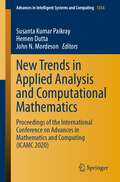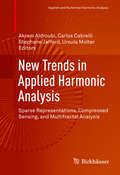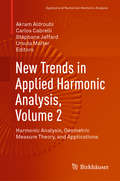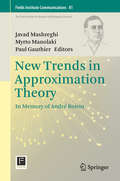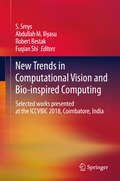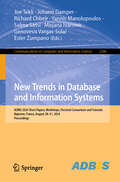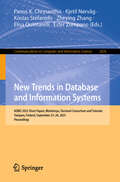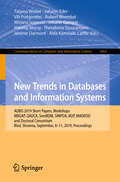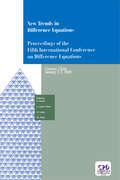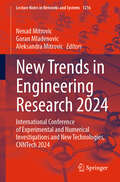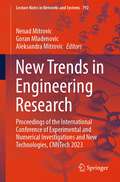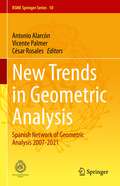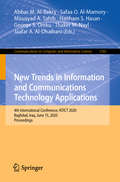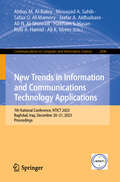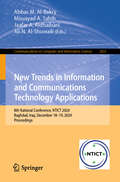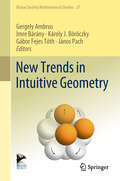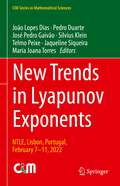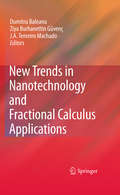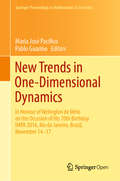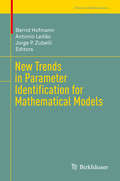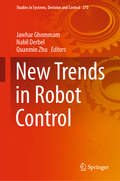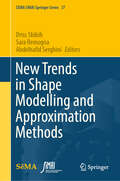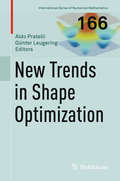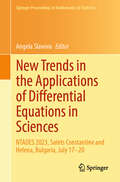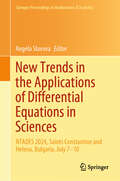- Table View
- List View
New Trends in Applied Analysis and Computational Mathematics
by John N. Mordeson Hemen Dutta Susanta Kumar PaikrayThe volume contains original research papers as the Proceedings of the International Conference on Advances in Mathematics and Computing, held at Veer Surendra Sai University of Technology, Odisha, India, on 7-8 February, 2020. It focuses on new trends in applied analysis, computational mathematics and related areas. It also includes certain new models, image analysis technique, fluid flow problems, etc. as applications of mathematical analysis and computational mathematics. <P><P> The volume should bring forward new and emerging topics of mathematics and computing having potential applications and uses in other areas of sciences. It can serve as a valuable resource for graduate students, researchers and educators interested in mathematical tools and techniques for solving various problems arising in science and engineering.
New Trends in Applied Harmonic Analysis
by Akram Aldroubi Carlos Cabrelli Stephane Jaffard Ursula MolterThis volume is a selection of written notes corresponding to courses taught at the CIMPA School: "New Trends in Applied Harmonic Analysis:Sparse Representations, Compressed Sensing and Multifractal Analysis". Newinteractions between harmonic analysis and signal and image processing haveseen striking development in the last 10 years, and several technologicaldeadlocks have been solved through the resolution of deep theoretical problemsin harmonic analysis. New Trends in Applied Harmonic Analysis focuses on twoparticularly active areas that are representative of such advances:multifractal analysis, and sparse representation and compressed sensing. Thecontributions are written by leaders in these areas, and cover boththeoretical aspects and applications. This work should prove useful not only toPhD students and postdocs in mathematics and signal and image processing,but also to researchers working in related topics.
New Trends in Applied Harmonic Analysis, Volume 2: Harmonic Analysis, Geometric Measure Theory, and Applications (Applied and Numerical Harmonic Analysis)
by Akram Aldroubi Carlos Cabrelli Ursula Molter Stéphane JaffardThis contributed volume collects papers based on courses and talks given at the 2017 CIMPA school Harmonic Analysis, Geometric Measure Theory and Applications, which took place at the University of Buenos Aires in August 2017. These articles highlight recent breakthroughs in both harmonic analysis and geometric measure theory, particularly focusing on their impact on image and signal processing. The wide range of expertise present in these articles will help readers contextualize how these breakthroughs have been instrumental in resolving deep theoretical problems. Some topics covered include:Gabor framesFalconer distance problemHausdorff dimensionSparse inequalitiesFractional Brownian motionFourier analysis in geometric measure theoryThis volume is ideal for applied and pure mathematicians interested in the areas of image and signal processing. Electrical engineers and statisticians studying these fields will also find this to be a valuable resource.
New Trends in Approximation Theory: In Memory Of André Boivin (Fields Institute Communications Ser. #81)
by Javad Mashreghi Myrto Manolaki Paul GauthierThe international conference entitled "New Trends in Approximation Theory" was held at the Fields Institute, in Toronto, from July 25 until July 29, 2016. The conference was fondly dedicated to the memory of our unique friend and colleague, André Boivin, who gave tireless service in Canada until his very last moment of his life in October 2014. The impact of his warm personality and his fine work on Complex Approximation Theory was reflected by the mathematical excellence and the wide research range of the 37 participants. In total there were 27 talks, delivered by well-established mathematicians and young researchers. In particular, 19 invited lectures were delivered by leading experts of the field, from 8 different countries. The wide variety of presentations composed a mosaic of aspects of approximation theory, highlighting interesting connections with important contemporary areas of Analysis. Primary topics discussed include application of approximation theory (isoperimetric inequalities, construction of entire order-isomorphisms, dynamical sampling); approximation by harmonic and holomorphic functions (especially uniform and tangential approximation), polynomial and rational approximation; zeros of approximants and zero-free approximation; tools used in approximation theory; approximation on complex manifolds, in product domains, and in function spaces; and boundary behaviour and universality properties of Taylor and Dirichlet series.
New Trends in Computational Vision and Bio-inspired Computing: Selected works presented at the ICCVBIC 2018, Coimbatore, India
by S. Smys Robert Bestak Fuqian Shi Abdullah M. IliyasuThis volume gathers selected, peer-reviewed original contributions presented at the International Conference on Computational Vision and Bio-inspired Computing (ICCVBIC) conference which was held in Coimbatore, India, on November 29-30, 2018. The works included here offer a rich and diverse sampling of recent developments in the fields of Computational Vision, Fuzzy, Image Processing and Bio-inspired Computing. The topics covered include computer vision; cryptography and digital privacy; machine learning and artificial neural networks; genetic algorithms and computational intelligence; the Internet of Things; and biometric systems, to name but a few. The applications discussed range from security, healthcare and epidemic control to urban computing, agriculture and robotics.In this book, researchers, graduate students and professionals will find innovative solutions to real-world problems in industry and society as a whole, together with inspirations for further research.
New Trends in Database and Information Systems: ADBIS 2024 Short Papers, Workshops, Doctoral Consortium and Tutorials, Bayonne, France, August 28–31, 2024, Proceedings (Communications in Computer and Information Science #2186)
by Richard Chbeir Yannis Manolopoulos Johann Gamper Mirjana Ivanovic Genoveva Vargas-Solar Ester Zumpano Joe Tekli Salma SassiThis book constitutes short papers, Doctoral Consortium and Workshops papers which were held in conjunction with the 28th European Conference on New Trends in Databases and Information Systems, ADBIS 2024, which took place in Bayonne, France, during August 28–31, 2024. The total of 28 full papers and 7 short papers presented in this book were carefully reviewed and selected from 103 submissions. They were organized in the following topical sections: Doctoral Consortium; 5th Workshop on Intelligent Data - From Data to Knowledge (DOING 2024); 3rd Workshop on Knowledge Graphs Analysis on a Large Scale (K-GALS 2024); 6th Workshop on Modern Approaches in Data Engineering and Information System Design (MADEISD 2024); 3rd Workshop on Personalization and Recommender Systems (PERS 2024); Access methods and query processing; discovery and data analysis; Machine Learning; large language models; and tutorials.
New Trends in Database and Information Systems: ADBIS 2025 Short Papers, Workshops, Doctoral Consortium and Tutorials, Tampere, Finland, September 23–26, 2025, Proceedings (Communications in Computer and Information Science #2676)
by Kjetil Nørvåg Panos K. Chrysanthis Ester Zumpano Kostas Stefanidis Elisa Quintarelli Zheying ZhangThis book constitutes short papers, Doctoral Consortium and workshop papers which were presented at the 29th European Conference on New Trends in Databases and Information Systems, ADBIS 2025, which took place in Tampere, Finland, during September 23-26, 2025. This CCIS proceedings book contains 14 short papers and 3 demo papers from the main ADBIS 2025 conference. In addition, 24 out of 48 papers submitted to the workshops are included in this book. The papers have been organized in topical sections as follows: Query Optimization; Spatio-Temporal & Graph Data; Data Sharing & Synthesis; Entity Resolution & Integration; Doctoral Consortium School Invited Talks; MADEISD 2025: 7th Workshop on Modern Approaches in Data Engineering and Information System Design; DOING 2025: 6th Workshop on Intelligent Data - From Data to Knowledge;K-GALS 2025: 4th Workshop on Knowledge Graphs Analysis on a Large Scale; CAIMA 2025: 1st Workshop on Cooperative AI Models and Applications; ERGA 2025: 1st Workshop on Entity Resolution and Graph Alignment; FEHDA 2025: 1st Workshop on Fairness Exploration in Heterogeneous Data and Algorithms; and IT4TOCI 2025: 1st Workshop on Information Technology for Tourism and Culture Industries.
New Trends in Databases and Information Systems: ADBIS 2019 Short Papers, Workshops BBIGAP, QAUCA, SemBDM, SIMPDA, M2P, MADEISD, and Doctoral Consortium, Bled, Slovenia, September 8–11, 2019, Proceedings (Communications in Computer and Information Science #1064)
by Mirjana Ivanović Tatjana Welzer Johann Eder Johann Gamper Robert Wrembel Jérôme Darmont Vili Podgorelec Mikoƚaj Morzy Theodoros Tzouramanis Aida Kamišalić LatifićThis book constitutes the thoroughly refereed short papers, workshops and doctoral consortium papers of the 23rd European Conference on Advances in Databases and Information Systems, ADBIS 2019, held in Bled, Slovenia, in September 2019.The 19 short research papers and the 5 doctoral consortium papers were carefully reviewed and selected from 103 submissions, and the 31 workshop papers were selected out of 67 submitted papers. The papers are organized in the following sections: Short Papers; Workshops Papers; Doctoral Consortium Papers; and cover a wide spectrum of topics related to database and information systems technologies for advanced applications.
New Trends in Difference Equations: Proceedings of the Fifth International Conference on Difference Equations Tampico, Chile, January 2-7, 2000
by S. Elaydi G. Ladas J. Lopez Fenner M. PintoThis series on the International Conference on Difference Equations and Applications has established a tradition within the mathematical community. It brings together scientists from many different areas of research to highlight current interests, challenges and unsolved problems. This volume comprises selected papers presented at the Fifth Interna
New Trends in Engineering Research 2024: International Conference of Experimental and Numerical Investigations and New Technologies, CNNTech 2024 (Lecture Notes in Networks and Systems #1216)
by Nenad Mitrovic Goran Mladenovic Aleksandra MitrovicThis book is a collection of high-quality peer-reviewed research papers presented at the International Conference of Experimental and Numerical Investigations and New Technologies (CNNTech2024) held in Belgrade, Serbia, from 24 June to 27 June 2024. The book discusses various industrial, engineering and scientific applications of engineering techniques. Researchers from academia and industry present their original work and exchange ideas, experiences, information, techniques, applications and innovations in mechanical engineering, materials science, chemical and process engineering, experimental techniques, numerical methods and new technologies.
New Trends in Engineering Research: Proceedings of the International Conference of Experimental and Numerical Investigations and New Technologies, CNNTech 2023 (Lecture Notes in Networks and Systems #792)
by Nenad Mitrovic Goran Mladenovic Aleksandra MitrovicThe book is a collection of high-quality peer-reviewed research papers presented at the International Conference of Experimental and Numerical Investigations and New Technologies (CNNTech2023) held at Zlatibor, Serbia from 4th July to 7th July 2023. The book discusses various industrial, engineering and scientific applications of engineering techniques. Researchers from academia and industry present their original work and exchange ideas, experiences, information, techniques, applications and innovations in mechanical engineering, materials science, chemical and process engineering, experimental techniques, numerical methods and new technologies.
New Trends in Geometric Analysis: Spanish Network of Geometric Analysis 2007-2021 (RSME Springer Series #10)
by Vicente Palmer Antonio Alarcón César RosalesThe aim of this book is to provide an overview of some of the progress made by the Spanish Network of Geometric Analysis (REAG, by its Spanish acronym) since its born in 2007. REAG was created with the objective of enabling the interchange of ideas and the knowledge transfer between several Spanish groups having Geometric Analysis as a common research line. This includes nine groups at Universidad Autónoma de Barcelona, Universidad Autónoma de Madrid, Universidad de Granada, Universidad Jaume I de Castellón, Universidad de Murcia, Universidad de Santiago de Compostela and Universidad de Valencia. The success of REAG has been substantiated with regular meetings and the publication of research papers obtained in collaboration between the members of different nodes.On the occasion of the 15th anniversary of REAG this book aims to collect some old and new contributions of this network to Geometric Analysis. The book consists of thirteen independent chapters, all of them authored by current members of REAG. The topics under study cover geometric flows, constant mean curvature surfaces in Riemannian and sub-Riemannian spaces, integral geometry, potential theory and Riemannian geometry, among others. Some of these chapters have been written in collaboration between members of different nodes of the network, and show the fruitfulness of the common research atmosphere provided by REAG. The rest of the chapters survey a research line or present recent progresses within a group of those forming REAG.Surveying several research lines and offering new directions in the field, the volume is addressed to researchers (including postdocs and PhD students) in Geometric Analysis in the large.
New Trends in Information and Communications Technology Applications: 4th International Conference, NTICT 2020, Baghdad, Iraq, June 15, 2020, Proceedings (Communications in Computer and Information Science #1183)
by George S. Oreku Abbas M. Al-Bakry Safaa O. Al-Mamory Mouayad A. Sahib Haitham S. Hasan Thaker M. Nayl Jaafar A. Al-DhaibaniThis book constitutes refereed proceedings of the 4th International Conference on New Trends in Information and Communications Technology Applications, NTICT 2020, held on June 15, 2020. The NTICT conference was planned to take place in Baghdad on March 11-12, 2019, but due to the COVID-19 pandemic the conference has been postponed on June 15, 2020 and moved to the virtual format.The 15 full papers and 3 short papers presented were thoroughly reviewed and selected from 90 qualified submissions. The volume presents the latest research results in such areas as network protocols, overlay and other logical network structures, wireless access networks, computer vision, machine learning, artificial Intelligence, data mining, control methods.
New Trends in Information and Communications Technology Applications: 7th National Conference, NTICT 2023, Baghdad, Iraq, December 20–21, 2023, Proceedings (Communications in Computer and Information Science #2096)
by Abbas M. Al-Bakry Safaa O. Al-Mamory Mouayad A. Sahib Haitham S. Hasan Jaafar A. Aldhaibani Ali N. Al-Shuwaili Rula A. Hamid Ali K. IdreesThis book constitutes the refereed proceedings of the 7th National Conference on New Trends in Information and Communications Technology Applications, NTICT 2023, held in Baghdad, Iraq, during December 20–21, 2023. The 28 full papers included in this book were carefully reviewed and selected from 92 submissions. They were organized in topical sections as follows: artificial intelligence and machine learning; and computer networks.
New Trends in Information and Communications Technology Applications: 8th National Conference, NTICT 2024, Baghdad, Iraq, December 18–19, 2024, Proceedings (Communications in Computer and Information Science #2455)
by Abbas M. Al-Bakry Mouayad A. Sahib Jaafar A. Aldhaibani Ali N. Al-ShuwailiThis book constitutes the refereed proceedings of the 8th National Conference on New Trends in Information and Communications Technology Applications, NTICT 2024, held in Baghdad, Iraq, during December 18–19, 2024. The 17 full papers included in this book were carefully reviewed and selected from 54 submissions. They were organized in topical sections as follows: Machine learning and Evolutionary computing.
New Trends in Intuitive Geometry (Bolyai Society Mathematical Studies #27)
by János Pach Imre Bárány Gergely Ambrus Károly J. Böröczky Gábor Fejes TóthThis volume contains 17 surveys that cover many recent developments in Discrete Geometry and related fields. Besides presenting the state-of-the-art of classical research subjects like packing and covering, it also offers an introduction to new topological, algebraic and computational methods in this very active research field. The readers will find a variety of modern topics and many fascinating open problems that may serve as starting points for research.
New Trends in Lyapunov Exponents: NTLE, Lisbon, Portugal, February 7–11, 2022 (CIM Series in Mathematical Sciences)
by Pedro Duarte Silvius Klein João Lopes Dias José Pedro Gaivão Telmo Peixe Jaqueline Siqueira Maria Joana TorresThis volume presents peer-reviewed surveys on new developments in the study of Lyapunov exponents in dynamical systems and its applications to other areas, such as mathematical physics. Written by leading experts in their fields, the contributions are based upon the presentations given by invited speakers at the “New Trends in Lyapunov Exponents” workshop held in Lisbon, Portugal, February 7–11, 2022. The works focus on the concept of Lyapunov exponents in their various manifestations in dynamical systems along with their applications to mathematical physics and other areas of mathematics. The papers reflect the spirit of the conference of promoting new connections among different subjects in dynamical systems. This volume aims primarily at researchers and graduate students working in dynamical systems and related fields, serving as an introduction to active fields of research and as a review of recent results as well.
New Trends in Nanotechnology and Fractional Calculus Applications
by Dumitru Baleanu J.A. Tenreiro Machado Ziya B. GuvencIn recent years fractional calculus has played an important role in various fields such as mechanics, electricity, chemistry, biology, economics, modeling, identification, control theory and signal processing. The scope of this book is to present the state of the art in the study of fractional systems and the application of fractional differentiation. Furthermore, the manufacture of nanowires is important for the design of nanosensors and the development of high-yield thin films is vital in procuring clean solar energy. This wide range of applications is of interest to engineers, physicists and mathematicians.
New Trends in One-Dimensional Dynamics: In Honour of Welington de Melo on the Occasion of His 70th Birthday IMPA 2016, Rio de Janeiro, Brazil, November 14–17 (Springer Proceedings in Mathematics & Statistics #285)
by Maria José Pacifico Pablo GuarinoThis volume presents the proceedings of the meeting New Trends in One-Dimensional Dynamics, which celebrated the 70th birthday of Welington de Melo and was held at the IMPA, Rio de Janeiro, in November 2016. Highlighting the latest results in one-dimensional dynamics and its applications, the contributions gathered here also celebrate the highly successful meeting, which brought together experts in the field, including many of Welington de Melo’s co-authors and former doctoral students.Sadly, Welington de Melo passed away shortly after the conference, so that the present volume became more a tribute to him. His role in the development of mathematics was undoubtedly an important one, especially in the area of low-level dynamics, and his legacy includes, in addition to many articles with fundamental contributions, books that are required reading for all newcomers to the field.
New Trends in Parameter Identification for Mathematical Models
by Bernd Hofmann Antonio Leitão Jorge P. ZubelliThe Proceedings volume contains 16 contributions to the IMPA conference “New Trends in Parameter Identification for Mathematical Models”, Rio de Janeiro, Oct 30 – Nov 3, 2017, integrating the “Chemnitz Symposium on Inverse Problems on Tour”. This conference is part of the “Thematic Program on Parameter Identification in Mathematical Models” organized at IMPA in October and November 2017. One goal is to foster the scientific collaboration between mathematicians and engineers from the Brazialian, European and Asian communities. Main topics are iterative and variational regularization methods in Hilbert and Banach spaces for the stable approximate solution of ill-posed inverse problems, novel methods for parameter identification in partial differential equations, problems of tomography , solution of coupled conduction-radiation problems at high temperatures, and the statistical solution of inverse problems with applications in physics.
New Trends in Robot Control (Studies in Systems, Decision and Control #270)
by Quanmin Zhu Nabil Derbel Jawhar GhommamThis book presents solutions to control problems in a number of robotic systems and provides a wealth of worked-out examples with full analytical and numerical details, graphically illustrated to aid in reader comprehension. It also presents relevant studies on and applications of robotic system control approaches, as well as the latest findings from interdisciplinary theoretical studies. Featuring chapters on advanced control (fuzzy, neural, backstepping, sliding mode, adaptive, predictive, diagnosis, and fault-tolerant control), the book will equip readers to easily tailor the techniques to their own applications. Accordingly, it offers a valuable resource for researchers, engineers, and students in the field of robotic systems.
New Trends in Shape Modelling and Approximation Methods (SEMA SIMAI Springer Series #37)
by Sara Remogna Driss Sbibih Abdelhafid SerghiniThis book presents recent research results from a selection of the talks presented in the international symposium “New Trends in Approximation and Applications”, held at Oujda, Morocco, in June 2022. The various chapters describe developments in approximation and its different applications including approximation methods in Numerical Analysis, curves and surfaces in CAGD, interpolation and smoothing, shape modelling and computational topology, subdivision schemes and applications, wavelets, and multiresolution methods. The book is addressed to researchers in all of these areas as well as in general mathematical modelling.
New Trends in Shape Optimization
by Aldo Pratelli Günter LeugeringThis volume reflects "New Trends in Shape Optimization" and is based on a workshop of the same name organized at the Friedrich-Alexander University Erlangen-Nürnberg in September 2013. During the workshop senior mathematicians and young scientists alike presented their latest findings. The format of the meeting allowed fruitful discussions on challenging open problems, and triggered a number of new and spontaneous collaborations. As such, the idea was born to produce this book, each chapter of which was written by a workshop participant, often with a collaborator. The content of the individual chapters ranges from survey papers to original articles; some focus on the topics discussed at the Workshop, while others involve arguments outside its scope but which are no less relevant for the field today. As such, the book offers readers a balanced introduction to the emerging field of shape optimization.
New Trends in the Applications of Differential Equations in Sciences: NTADES 2023, Saints Constantine and Helena, Bulgaria, July 17–20 (Springer Proceedings in Mathematics & Statistics #449)
by Angela SlavovaThis book convenes peer-reviewed, selected papers presented at the Tenth International Conference New Trends in the Applications of Differential Equations in Sciences (NTADES) held in Saints Constantine and Helena, Bulgaria, July 17–20, 2023. Contributions are devoted to many applications of differential equations in different fields of science. A number of phenomena in nature (physics, chemistry, biology) and in society (economics) result in problems leading to the study of linear and nonlinear differential equations, stochastic equations, statistics, analysis, numerical analysis, optimization, and more. The main topics are presented in the five parts of the book - applications in mathematical physics, mathematical biology, financial mathematics, neuroscience, and fractional analysis.In this volume, the reader will find a wide range of problems concerning recent achievements in both theoretical and applied mathematics. The main goal is to promote the exchange of new ideas and research between scientists, who develop and study differential equations, and researchers, who apply them to solve real-life problems. The book promotes basic research in mathematics leading to new methods and techniques useful for applications of differential equations.
New Trends in the Applications of Differential Equations in Sciences: NTADES 2024, Saints Constantine and Helena, Bulgaria, July 7–10 (Springer Proceedings in Mathematics & Statistics #488)
by Angela SlavovaThis volume compiles selected papers focusing on the applications of differential equations across various scientific domains, presented at the International Conference "New Trends in the Applications of Differential Equations in Sciences" (NTADES), which took place in Saints Constantine and Helena, Bulgaria, in July 2024. The book is organized around several key themes, including applications in mathematical physics, mathematical biology, financial mathematics, fractional analysis, numerical methods, and neuroscience. The covered applications encompass diverse topics such as mechanics, neural networks in insurance, credit portfolios, predator-prey systems with fractional derivatives, recent findings regarding COVID-19 epidemic waves, memristive cellular nonlinear networks, and more. By promoting fundamental research in mathematics, this book aims to develop new methods and techniques that can effectively address real-life challenges through the application of differential equations.
